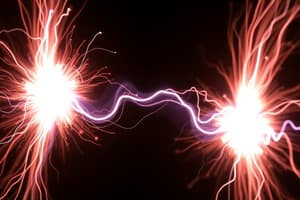Podcast
Questions and Answers
According to Ampère's law, what does the magnitude of the circular magnetic field produced by an electric current depend on?
According to Ampère's law, what does the magnitude of the circular magnetic field produced by an electric current depend on?
- The color of the wire
- The temperature of the conductor
- The size of the current and the area enclosed by the loop (correct)
- The type of metal used
What type of field is generated around a conductor when an electric current flows through it?
What type of field is generated around a conductor when an electric current flows through it?
- Magnetic field (correct)
- Electric field
- Gravity field
- Sound field
How does winding multiple loops of wire together affect the magnetic fields generated?
How does winding multiple loops of wire together affect the magnetic fields generated?
- It has no effect on the magnetic fields
- It creates more powerful magnetic fields (correct)
- It reverses the direction of the magnetic fields
- It weakens the magnetic fields
What does Faraday's Law describe when a cable passes through a changing magnetic field?
What does Faraday's Law describe when a cable passes through a changing magnetic field?
Which principle forms the basis of electromagnets and transformers?
Which principle forms the basis of electromagnets and transformers?
How does external magnetic fields interact with electric wires?
How does external magnetic fields interact with electric wires?
What phenomenon allows us to produce electricity using generators and motors?
What phenomenon allows us to produce electricity using generators and motors?
What is responsible for converting electrical energy into thermal energy in the presence of resistance?
What is responsible for converting electrical energy into thermal energy in the presence of resistance?
How is Joule heating related to resistance and current?
How is Joule heating related to resistance and current?
What can happen if cables experience excessive heating?
What can happen if cables experience excessive heating?
Who first discovered the relationship between current squared multiplied by resistance and heat generation?
Who first discovered the relationship between current squared multiplied by resistance and heat generation?
Why do designers need to consider resistances and temperatures during electrical installation planning?
Why do designers need to consider resistances and temperatures during electrical installation planning?
Flashcards are hidden until you start studying
Study Notes
Exploring Electric Current's Impact on Magnetic Fields and Heat Generation
Electric current is the flow of charged particles through conductive materials, most often electrons moving within metals. This fundamental phenomenon has far-reaching effects beyond mere illumination or powering appliances. In this discussion, we'll delve into two aspects of these effects—the magnetic interactions resulting from electric current and the energy transformation leading to heat production.
Magnetism and Electric Current
When an electric current flows through a conductor, it generates a magnet field around itself due to the movement of charges. According to Ampère's law, an electric current flowing through a closed loop produces a circular magnetic field with magnitude directly proportional to the size of the current and the area enclosed by the loop. Consequently, if you wind multiple loops of wire together, they will create more powerful magnetic fields because their collective current amplifies the total flux generated. This principle forms the basis of electromagnets and transformers.
In addition to induced magnets, electric wires can interact with external magnetic fields too. For instance, when passing through a changing magnetic field, a cable picks up voltage according to Faraday's Law, generating electricity known as induced emf ("electromotive force"). This interaction between current and magnetic fields allows us to produce electricity using generators, motors, and other devices.
Thermal Effects of Electric Current
The conversion of electrical energy into thermal energy occurs whenever there is resistance in an electrical circuit. Resistance creates friction, causing the charged particles to slow down, which results in dissipated energy being converted into heat. In some cases, such as incandescent light bulbs, heat production is desired since it causes filaments inside the bulb to glow brightly. However, excessive heating of cables can cause them to overheat, melt, or even start fires, so designers need to account for resistances and temperatures during electrical installation planning.
Aside from losses caused by ohmic resistance, Joule heating also contributes significantly to temperature increases in circuits. Named after James Prescott Joule, who first discovered its relationship to current squared multiplied by resistance (I²R), Joule heating affects nearly every electric circuit, whether in homes or industry. Therefore, engineers consider both power (P = V x I) and resistance (R = Ω) to accurately predict how much heat will be produced and ensure safe operation of systems based upon calculated temperatures.
Understanding the effects of electric current helps us better design safer, more efficient technologies while simultaneously expanding our scientific knowledge. By exploring magnetic phenomena and heat production resulting from electric current, researchers and engineers continue innovating techniques that improve daily life while pushing technological boundaries forward.
Studying That Suits You
Use AI to generate personalized quizzes and flashcards to suit your learning preferences.




